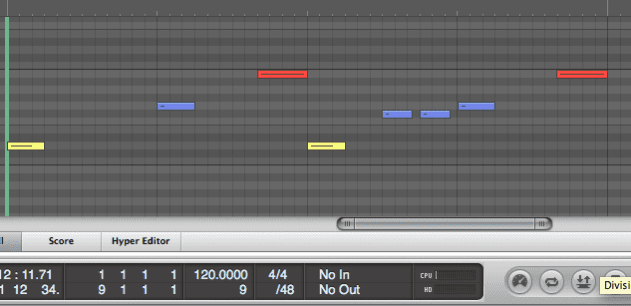Polyrhythms in dance music are an amazingly simple way of adding complexity to your tracks. Dance music theory expert Oliver Curry deconstructs two classic examples and shows how to use them in your own music.
In this edition of Passing Notes, we’re going to take a look at polyrhythms. A polyrhythm is the use of two or more simultaneous rhythms in different time signatures. As we’ll see, these rhythmic contrasts can be incorporated into any elements of a track. We’ll take a look at examples from Aphex Twin and Zomby – two of the finest exponents of polyrhythms – see how they can also work in house and techno, then construct an example from scratch.
Windowlicker
A fantastic reference point for the concept of polyrhythms is Richard D. James’s track ‘Windowlicker’ which, alongside incredible sound design and production, subtly uses simultaneous contrasting rhythms to create its characteristic laid-back feel.
Without undertaking the near-impossible task of recreating the sounds of the original, we can use basic examples to look at a couple of key rhythmic components to the track and see how they combine to such an effective result.
The kick, snare and synth patterns that start at 0:51 are in a straight 4/4 rhythm, as we can hear replicated in the first four bars of the audio below. However, the quiet offbeat hi-hats that come in during the second four bars of the sample are in a 6/8. In this very stripped down recreation, we can hear how a hi-hat rhythm in 6/8 can affect the feel of the piece in 4/4:

Here, the hi-hats are highlighted in red, the kick in yellow and the snares in blue. By setting the piano-roll grid to 48th notes, we can read our sequencer in both 6/8 and 4/4 easily. (Every three 48ths will give you 16ths, thus keeping the part in 4/4. Every four 48ths is a 12th, which will divide the beats into 3rds. If you’re scratching your head, don’t worry – the important point to remember is that both 6/8 and 4/4 fall perfectly on the gridlines with the grid divisions set to 48ths .)
There are numerous other elements to ‘Windowlicker’ that also use this contrast of rhythms. The main vocal melodies, for example, are also in a 6/8 time signature, whilst subtle drum loops roll underneath on the 16ths, very low in the mix.
One Foot Ahead Of The Other
Let’s look now at Zomby’s track ‘Helter Skelter’, from 2009’s One Foot Ahead Of The Other EP:
In particular, we’re looking at the section starting at 0:13. The drum loop, colour-coded as before, with the hi-hats red, snare in blue, kick in yellow, looks like this:

We can see that all the drum hits in this loop, land on 16th (again, every third 48th is a 16th, every fourth 48th is a 12th). However, if we look at the sawtooth bass line, sequenced below, we can see that it’s in 6/8, with each note landing on a 12th of the piano roll.

And here’s how the two contrasting time signatures sound together:
For a direct comparison of the effect this polyrhythm has on the sound, let’s compare the same loop without a polyrhythm. Here’s the result if we quantise the drums to 6/8 time to match the bass:

Without the polyrhythm, the loop is much more predictable and lacks its distinctive character. Other similar examples of polyrhythm can be throughout the track ‘Bubble Bubble’ from the same EP.
Next, let’s have a listen to how polyrhythms can be applied to tracks which follow more traditional house and techno approaches…
Disclosure and Henrik Schwarz
Although Aphex’s pioneering IDM and Zomby’s unique twist on grime, hardcore and dubstep both lend themselves well to complex rhythmic elements, polyrhythms can be employed just as effectively in house and techno. Let’s take a quick listen to two more examples to hear how well this can work.
In Disclosure’s track ‘Tenderly’, we can hear how the timing of the claps and percussion layers contrasts with the keys, kick, bass and additional percussion hit which come in at 1:01, giving the piece a strong ‘shuffle’ feel for the first two bars of each phrase:
Similarly, Henrik Schwarz’s remix of Mari Boine’s ‘Vuoi Vuoi Me’ employs a polyrhythm throughout, sucking the listener into the complex timing of the synth bass loop in the intro before laying a 4/4 kick drum on top at the 1:05 mark:
Polyrhythm Dub
Finally, let’s create an example from scratch. The short loop below uses a kick and snare pattern, bassline and keys all in 4/4, but hi-hats and a harmonised marimba fills in 6/8, landing on the 12ths as opposed to the 16ths.
Here’s a piano roll of the kick and snare in 4/4, with the hi-hats in 6/8:

And the 4/4 bassline in yellow, underneath the 6/8 marimba in green:
The result sounds like this:
We can hear how the feel of the beat, bass and keys is instantly changed by the addition of the contrasting rhythm on the hi-hats. When the bassline drops out at the end, the hi-hats switch to a pattern on the 16ths rather than the 12ths of the beats, making it clear how the polyrhythm affected the beat.
The easiest way to experiment with polyrhythms in your own tracks is to start with relatively simple time signatures. Try playing or programming one element in 4/4 and one in 6/8, then mixing them together. As you get to grips with the concept you’ll realise there are no limits. Bassline in 15/8 and drums in 5/4? If you can make it work, there’s nothing to stop you. Polyrhythms really do prove the old music production adage that if it sounds right it is right.

06.42 PM
this is great thank u
01.04 AM
Thank you thank you thank you thank you for turning me on to the Henrik Schwarz remix on the second page.
HOT DAMN WHAT A TRACK
06.08 PM
do 8th note triplets in 4/4 time also equal 6/8 time?
12.55 AM
Thats correct ED, its combination of triplets and straight 8ths and their divisions
12.59 AM
The way you talk about the windowlicker beat makes it seem like the kick and snare create contrast to the hihats. Since these lie on the beat im pretty sure the only thing that creates a polyrhythm with the hats is the 16th ghost snares.
Correct me if im wrong please
06.12 PM
Hi Ian
Yes, you’re right. As the kick and snare are simply on every beat, they don’t technically create a polyrhythm with the hats as they could be in the same place if the whole thing was in 6/8. However, in my opinion, the contrast in time signature is implied by the synth/keys as well as those ghost snares.
Cheers
04.18 PM
What does the 48th mean on the first page? I am a bit confused? I mean it says lands on the 48th and the n the twelth Can some one help?
03.26 PM
Actually it’s very easy and fun to write a song in 5/4 with a bassline in 15/8…Phrase every quarter as triplet and accent every fifth triplet…Voila!!! a bass line in 15… 🙂